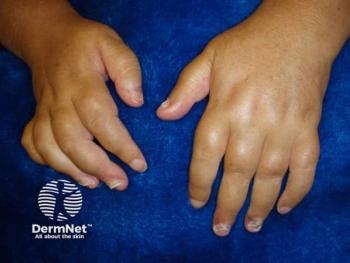
Phase 3 Tapinarof Data Released
The New England Journal of Medicine has published the clinical trial data from the PSOARING 1 and PSOARING 2 studies on tapinarof treatment for plaque psoriasis.
Phase 3 data from PSOARING 1 (NCT03956355) and PSOARING 2 (NCT03983980) was recently published in The New England Journal of Medicine giving the efficacy and safety profile of tapinarof (Dermavant Sciences), an investigational, novel, therapeutic aryl hydrocarbon receptor modulating agent, for the treatment of mild to severe plaque psoriasis.1
PSOARING 1 and 2 are 2 identical phase 3 randomized, mutli-center, double-blind, vehicle-controlled trials with adult patients 18 to 75 years diagnosed plaque psoriasis. Each patient was given a baseline Physician’s Global Assessment (PGA) score of 2 (mild) to 4 (severe), the scale being 0 to 4, and a percent of total body surface area (BSA) of 3% to 20% then randomized in a 2:1 ratio to either tapinarof 1% cream or vehicle cream once daily for 12 weeks.
Patients had visits at 2, 4, 8, and 12 weeks. After the trials, patients had the option to enroll in a separate open-label, long-term extension trial (PSOARING 3; NCT04053387). Patients were instructed to apply a thin layer of cream once daily to cover psoriasis lesions completely, including newly appearing lesions and any lesions or areas in which psoriasis abated or cleared during the trial, according to the article.
The primary end point of both trials was a PGA score of 0 (clear) or 1 (almost clear) and a decrease of at least 2 points at week 12 from baseline. The secondary efficacy end points at week 12 was a decrease of at least 75% in the Psoriasis Area and Severity Index (PASI 75) score, a PGA score of 0 or 1, the mean change from baseline in the percent of body-surface area affected, and a reduction of 90% or more in the PASI score.
The patient-reported outcomes were the mean changes from baseline to week 12 in the proportion of patients who had a decrease of at least 4 points in the Peak Pruritus Numeric Rating Scale (PP-NRS) score (range, 0 [no itch] to 10 [worst imaginable itch]), the PP-NRS total score, the Dermatology Life Quality Index (DLQI) total score, and the Psoriasis Symptom Diary (PSD), according to the article.
Trial 1 was conducted from April 25, 2019, to May 26, 2020, and trial 2 from May 30, 2019, to May 13, 2020. In PSOARING 1, 692 patients were screened and 510 were enrolled, and in PSOARING 2, 674 patients were screened, and 515 patients were enrolled. In trial 1, a total of 340 patients in the tapinarof 1% cream arm and 170 in the vehicle cream arm; in trial 2, a total of 343 patients were in the tapinarof 1% cream arm and 172 in the vehicle cream arm.
At baseline in both trial 1 and 2, 79.2% and 83.9% of the patients, respectively, had a PGA score of 3 (moderate), the mean PASI score was 8.9 and 9.1, and the mean body-surface area affected by psoriasis was 7.9% and 7.6%.
Of the patients in the tapinarof arm, 35.4% of achieved a PGA response and 6% in the vehicle cream in trial 1. In the second trial, 40.2% and 6.3%, respectively, achieved response with a P < .001 for both comparisons.
At week 12, 36.1% of patients in trial 1 achieved PASI 75 response in the tapinarof group, vs 10.2% of those in the vehicle group, in trial 1 (difference, 25.9% points; relative rate, 2.8; 95% CI, 1.7 to 4.5; P < .001). Compared to trial 2, 47.6% and 6.9% of patients achieved PASI 75 (difference, 40.7% points; relative rate, 6.5 ;95% CI, 3.7 to 11.5; P < .001).
The percentage of patients with a PGA score of 0 or 1 at week 12 was 37.8% in the tapinarof group, as compared with 9.9% in the vehicle group, in trial 1 (difference, 27.9% points; relative rate, 2.7; 95% CI, 1.6 to 4.4; P < .001); the corresponding values in trial 2 were 43.6% and 8.1% (difference, 35.5% points; relative rate, 4.6; 95% CI, 2.7 to 7.6; P < .001), the article continued.
Results for secondary end points and patient-reported outcomes were generally in the same direction as those for the primary end point. About 50% of patients in the tapinarof arm in trial 1 and 54.5% of those in trial 2 experienced adverse events (AEs) compared to 22.4% and 26.2% in the vehicle cream, respectively.
The AEs reported with tapinarof cream included folliculitis, nasopharyngitis, contact dermatitis, headache, upper respiratory tract infection, and pruritus.
“Larger and longer trials are needed to evaluate the efficacy and safety of tapinarof cream as compared with existing treatments for psoriasis,” the author’s concluded.
These studies were funded by Dermavant Sciences.
Reference:
1. Lebwohl, MD MG, Stein Gold, MD L, Strober, MD B, et al. Phase 3 Trials of Tapinarof Cream for Plaque Psoriasis. The New England Journal of Medicine. 2021;385(24):2219-2229.
Newsletter
Like what you’re reading? Subscribe to Dermatology Times for weekly updates on therapies, innovations, and real-world practice tips.


















